Net Promoter Score (NPS) is great for a quick overview of customer satisfaction and brand health. But NPS ignores nuance. A single number can’t tell you why customers feel the way they do. The upshot? You may be making bad decisions based on misleading NPS metrics. In a world where customer experience is everything, this can be disastrous.
Key take-aways
A high Net Promoter Score doesn’t mean your brand is healthy
People often leave comments that don’t match their NPS
You can fill this consumer insights gap by analyzing open-ended survey responses, social comments and online reviews
For best results, combine NPS and NLP-powered BI tools into a holistic Voice of Customer program
Read on to learn more about the dangers of measuring customer satisfaction with pure-NPS, and how you can use NLP-powered BI tools to fill this customer insights gap.
1. What is NPS?
2. The benefits of NPS
3. Why is it bad to rely on NPS alone?
4. The NPS insights gap
5. How NPS can be misleading
6. Bridging the NPS insights gap
7. Customer review analytics in action
8. How to build a better Voice of Customer program
What is NPS?
Net Promoter Score (NPS) is a single-question survey designed to measure customer brand loyalty. NPS asks,
“How likely are you to recommend [Company X] to a friend or colleague?”
Customers can answer on a scale:
0-6 = Detractor
7-8 = Passive
9-10 = Promoter
Promoters are likely to buy again or generate referral business. Detractors are unlikely to buy again and may actively discourage others. Passives fall between the two.
A company’s net promoter score is a simple calculation:
Company NPS = [% Promoters] – [% Detractors]

As we’ll see, NPS is a versatile number that offers a wide range of benefits and practical applications. But NPS can be dangerously misleading without deeper, supplemental business intelligence.
The benefits of NPS
First and foremost, the NPS system is proven to increase survey response rates by giving customers a chance to have their voice heard, without requiring a substantial time investment.
Next, a company’s Net Promoter Score can simultaneously be taken as a snapshot and tracked over time for predictive analytics.
Third, NPS can be measured by company, product, franchise location, support agent, and a wide range of vectors.
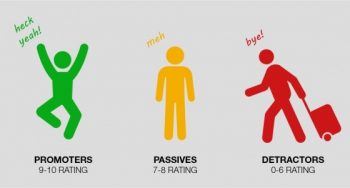
Fourth, NPS can serve as a predictor of business growth. A Promoter’s customer lifecycle value (CLV) is usually higher than a Detractor’s or Passive’s. So, a higher NPS naturally correlates with higher revenue, and vice versa.
Fifth, NPS drives rapid changes in policies, products and processes. By using a simple, shared vocabulary, NPS lets you quickly share information within an organization, while being sure that everyone reaches the same conclusions. This helps companies reduce the communication delay between customers, support agents, and product managers.
Finally, you can compare your company’s aggregated Net Promoter Score against your competitors for a simple picture of your brand’s relative health. If your business has an NPS of 70, but your chief competitor boasts a 90, you know to start digging deeper to find out why.
In short, the Net Promoter Score system is a simple, easy way for businesses to paint a clear picture of consumer opinion and brand health.
For these reasons and more, NPS has become a go-to customer success metric for companies and agencies across every industry and vertical. But NPS isn’t enough on its own.
Why is it bad to rely on NPS alone?
The NPS system delivers an easy-to-understand measure of customer satisfaction. And because NPS questions generate more responses than traditional satisfaction surveys, NPS can give you more data to act on. But in the end, this is a dangerous oversimplification. A high NPS doesn’t mean your brand is healthy.
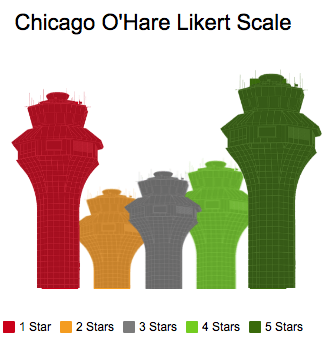
Customers don’t care about your NPS. They want to know that they’ll enjoy the experience of using your products and services. And without understanding why you’re receiving your scores, and without giving your customers the chance to tell you in their own words, you’ll never have the data you need to make informed, effective decisions.
The “why” comes from open-ended survey responses, customer comments, social media posts, and online reviews (which is an information source that is notoriously challenging and labor-intensive to utilize). As we’ll show, this is where natural language processing comes into play.
The NPS insights gap
Meet Stephanie.

Stephanie just wrapped up a four-night stay at a San Francisco hotel while in town for a conference. When asked how likely she’d be to recommend the hotel to others, Stephanie responds with an enthusiastic 9.
Sounds great, right? Another promoter created, a higher NPS for the hotel, and a happy management team. Bonuses all around!
Not so fast. Stephanie also left a free-text comment on the same survey:
“Stayed for 4 nights. The room was spotless, and the bed was super comfy. Especially loved the shampoo and conditioner in the bathroom since I forgot mine at home! I did notice the fruit in the bowl at the front desk looked off and the breakfast was kind of lame. But overall a great stay.”
Overall, Stephanie describes a positive experience and offered a generous Net Promoter Score. But her comment raises two red flags that demand attention: rotten fruit and a “lame” breakfast.
How NPS can be misleading
As we said before, NPS deliberately ignores the nuance of open-response customer surveys in favor of higher response rates and fast action. That’s a fine way to gather basic feedback. But customers often leave comments that don’t match their Net Promoter Score. Ignoring this disconnect can seriously damage your business.
Remember that Stephanie gave her hotel a Net Promoter Score of 9. In her open-ended survey comment, however, she mentioned that the fruit at the front desk looked old and the breakfast was “lame”. Both of these data points are valuable. But a traditional NPS system will totally ignore the critical feedback about the front desk and breakfast service.
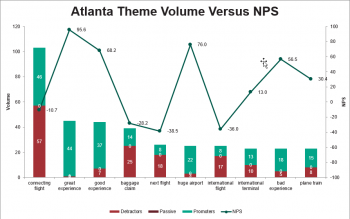
Evaluating NPS by Themes from real customer reviews of Atlanta International Airport – read our full analysis
And it gets worse. What happens if Stephanie posts her review on TripAdvisor, Yelp, or the hotel’s Facebook page? That shiny NPS may be quickly overshadowed by lost revenue from people turned off by her review.
Without a system in place to analyze Stephanie’s open-ended comment and identify her complaints, the hotel’s managers may never even know why business is down.
Bridging the NPS insights gap
As Stephanie’s story demonstrates, a customer’s Net Promoter Score and their actual comments can send two very different messages.
The best way to fill this “NPS insights gap” is, of course, to read survey responses, online reviews, social comments, and other sources of open-ended feedback.
But the sheer volume of this text is impossible to handle. Until recently, businesses had to comb through customer satisfaction surveys and online review sites by hand. This was a tedious process that required an enormous labor investment for minimal returns.
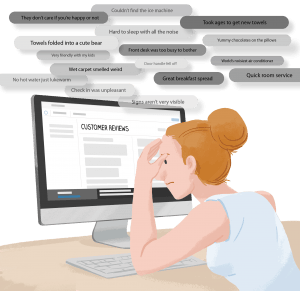
[woman feeling overwhelmed by customer reviews.png]
As a result, customers had few channels through which they could tell companies about their experiences. Companies were all-but-deaf to these stories, and everyone suffered for it.
Today, however, customer feedback analytics tools enable you to analyze thousands of open-ended survey responses and real, unstructured customer comments and reviews, all in the time it takes to brew your morning coffee.
These solutions combine natural language processing and artificial intelligence to show you how people talk about their experiences with your products, brands and services, in their own words.

Through intuitive dashboards, you can see exactly what people are talking about, how they feel about those subjects, and why they feel that way.
In short: By analyzing open-ended survey responses and real customer comments, you’ll catch the valuable, context-rich data that NPS systems would fail to pick up on.
The outcome? Better customer experiences can increase lifecycle value 6-14x, reduce churn up to 55% and grow revenue 4-8% (source).
Customer review analytics in action
The flexibility and customizability of these platforms make them applicable across industries and verticals, particularly in hospitality/transportation, financial services, pharmaceuticals, and retail.
For example, take a look at this dashboard built in the Lexalytics Intelligence Platform, using a data set of Facebook reviews of San Francisco International Airport (SFO).
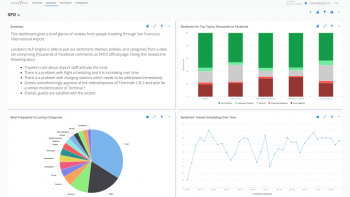
Click image to enlarge, or read our full analysis of SFO reviews
This dashboard tells a compelling story of traveler experiences at SFO.
Overall, guests are satisfied with the airport – but there are several areas of concern that the airport’s management should investigate. For one, there’s a problem with the charging stations that needs to be addressed immediately. Travelers are complaining about flight scheduling, and mentions of this issue have been increasing over time. And Terminal 1 should be speedily modernized like Terminals 2 and 3.
Through rich, multi-layered analytics dashboards like this one, you can uncover compelling stories of customer experiences, as they tell it.
How to build a better Voice of Customer program
To be clear: Net Promoter Score can and should still have a role in your customer experience management. But as we’ve demonstrated, the NPS insights gap can lead you unwittingly into disaster.
To fill this gap, combine NPS and an NLP-powered Voice of Customer analytics tool to paint detailed pictures of customer experiences.
For example, send NPS surveys for a quick, easily-digestible snapshot of brand health. Use this information to make fast, agile changes.
Meanwhile, use your VoC platform to analyze unstructured customer comments, reviews, and open-ended survey responses at scale.

Together, this comprehensive VoC analytics program will deliver the detailed information you need to make informed, effective changes to improve your customer experience.
This article was first published here.




Question: If an organization has to jump this many puddles to make NPS at least minimally useful as a macro metric, is the value commensurate with the investment of resources? After close to 20 years of its creators saying what a wonderful measure it is, this is important to consider. There have been, and are, much better gauges of customer sentiment and intended behavior.
Great article. A better way to get customer insight is to measure Customer Value Added, the ratio of the value your company offers to its customers versus the value your competition offers to its customers.
This is done through customer research. You can get more from my books, Total Customer Value Management and Creating Customer Value Makes you a Great Executive